roof rack CHRYSLER PACIFICA 2023 Owners Manual
[x] Cancel search | Manufacturer: CHRYSLER, Model Year: 2023, Model line: PACIFICA, Model: CHRYSLER PACIFICA 2023Pages: 328, PDF Size: 16.37 MB
Page 5 of 328
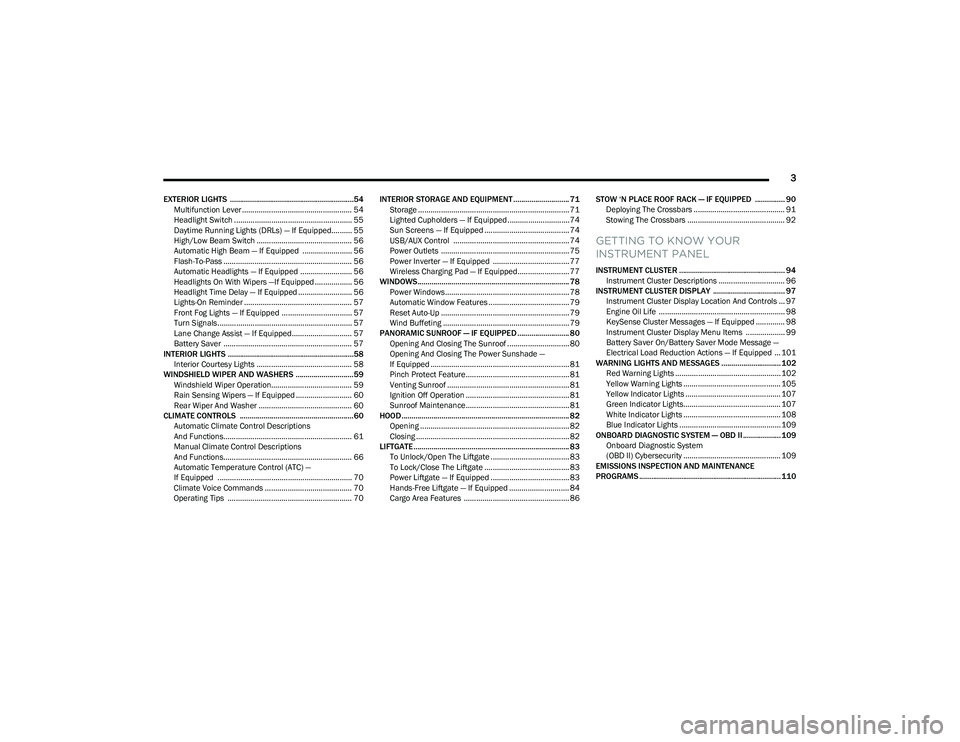
3
EXTERIOR LIGHTS ..............................................................54Multifunction Lever ..................................................... 54
Headlight Switch ......................................................... 55
Daytime Running Lights (DRLs) — If Equipped.......... 55
High/Low Beam Switch .............................................. 56
Automatic High Beam — If Equipped ........................ 56
Flash-To-Pass .............................................................. 56
Automatic Headlights — If Equipped ......................... 56
Headlights On With Wipers —If Equipped .................. 56
Headlight Time Delay — If Equipped .......................... 56
Lights-On Reminder .................................................... 57
Front Fog Lights — If Equipped .................................. 57
Turn Signals................................................................. 57
Lane Change Assist — If Equipped............................. 57
Battery Saver .............................................................. 57
INTERIOR LIGHTS ...............................................................58 Interior Courtesy Lights .............................................. 58
WINDSHIELD WIPER AND WASHERS .............................59 Windshield Wiper Operation....................................... 59
Rain Sensing Wipers — If Equipped ........................... 60
Rear Wiper And Washer ............................................. 60
CLIMATE CONTROLS .........................................................60 Automatic Climate Control Descriptions
And Functions.............................................................. 61
Manual Climate Control Descriptions
And Functions.............................................................. 66
Automatic Temperature Control (ATC) —
If Equipped ................................................................. 70
Climate Voice Commands .......................................... 70
Operating Tips ............................................................ 70 INTERIOR STORAGE AND EQUIPMENT ............................ 71
Storage ......................................................................... 71
Lighted Cupholders — If Equipped..............................74
Sun Screens — If Equipped ......................................... 74
USB/AUX Control ........................................................ 74
Power Outlets .............................................................. 75
Power Inverter — If Equipped ..................................... 77
Wireless Charging Pad — If Equipped......................... 77
WINDOWS............................................................................ 78 Power Windows............................................................ 78
Automatic Window Features ....................................... 79
Reset Auto-Up .............................................................. 79
Wind Buffeting ............................................................. 79
PANORAMIC SUNROOF — IF EQUIPPED .......................... 80 Opening And Closing The Sunroof ..............................80
Opening And Closing The Power Sunshade —
If Equipped ................................................................... 81
Pinch Protect Feature.................................................. 81
Venting Sunroof ........................................................... 81
Ignition Off Operation .................................................. 81
Sunroof Maintenance.................................................. 81
HOOD.................................................................................... 82 Opening ........................................................................ 82
Closing .......................................................................... 82
LIFTGATE .............................................................................. 83 To Unlock/Open The Liftgate ......................................83
To Lock/Close The Liftgate ......................................... 83
Power Liftgate — If Equipped ......................................83
Hands-Free Liftgate — If Equipped ............................. 84
Cargo Area Features ................................................... 86 STOW ‘N PLACE ROOF RACK — IF EQUIPPED ............... 90
Deploying The Crossbars ............................................ 91
Stowing The Crossbars ............................................... 92
GETTING TO KNOW YOUR
INSTRUMENT PANEL
INSTRUMENT CLUSTER ..................................................... 94 Instrument Cluster Descriptions ................................ 96
INSTRUMENT CLUSTER DISPLAY .................................... 97 Instrument Cluster Display Location And Controls ... 97
Engine Oil Life ............................................................. 98
KeySense Cluster Messages — If Equipped .............. 98
Instrument Cluster Display Menu Items ................... 99
Battery Saver On/Battery Saver Mode Message —
Electrical Load Reduction Actions — If Equipped ... 101
WARNING LIGHTS AND MESSAGES ..............................102 Red Warning Lights ................................................... 102
Yellow Warning Lights ............................................... 105Yellow Indicator Lights .............................................. 107Green Indicator Lights............................................... 107White Indicator Lights ............................................... 108Blue Indicator Lights ................................................. 109
ONBOARD DIAGNOSTIC SYSTEM — OBD II ................... 109 Onboard Diagnostic System
(OBD II) Cybersecurity ............................................... 109
EMISSIONS INSPECTION AND MAINTENANCE
PROGRAMS ....................................................................... 110
23_RUP_OM_EN_USC_t.book Page 3
Page 83 of 328
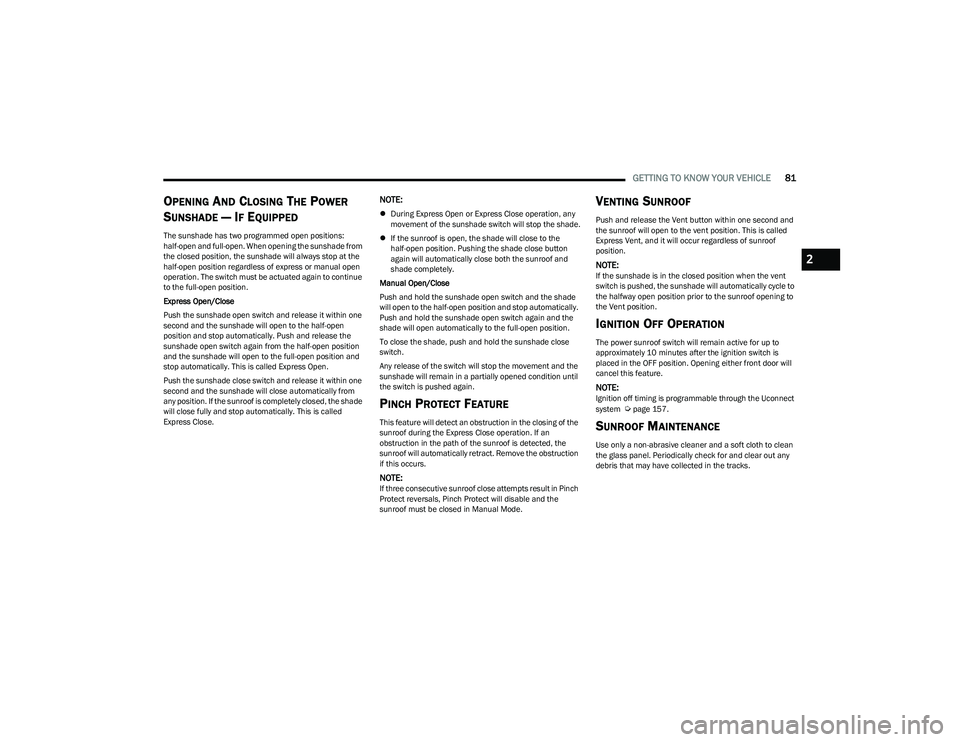
GETTING TO KNOW YOUR VEHICLE81
OPENING AND CLOSING THE POWER
S
UNSHADE — IF EQUIPPED
The sunshade has two programmed open positions:
half-open and full-open. When opening the sunshade from
the closed position, the sunshade will always stop at the
half-open position regardless of express or manual open
operation. The switch must be actuated again to continue
to the full-open position.
Express Open/Close
Push the sunshade open switch and release it within one
second and the sunshade will open to the half-open
position and stop automatically. Push and release the
sunshade open switch again from the half-open position
and the sunshade will open to the full-open position and
stop automatically. This is called Express Open.
Push the sunshade close switch and release it within one
second and the sunshade will close automatically from
any position. If the sunroof is completely closed, the shade
will close fully and stop automatically. This is called
Express Close.
NOTE:
During Express Open or Express Close operation, any
movement of the sunshade switch will stop the shade.
If the sunroof is open, the shade will close to the
half-open position. Pushing the shade close button
again will automatically close both the sunroof and
shade completely.
Manual Open/Close
Push and hold the sunshade open switch and the shade
will open to the half-open position and stop automatically.
Push and hold the sunshade open switch again and the
shade will open automatically to the full-open position.
To close the shade, push and hold the sunshade close
switch.
Any release of the switch will stop the movement and the
sunshade will remain in a partially opened condition until
the switch is pushed again.
PINCH PROTECT FEATURE
This feature will detect an obstruction in the closing of the
sunroof during the Express Close operation. If an
obstruction in the path of the sunroof is detected, the
sunroof will automatically retract. Remove the obstruction
if this occurs.
NOTE:If three consecutive sunroof close attempts result in Pinch
Protect reversals, Pinch Protect will disable and the
sunroof must be closed in Manual Mode.
VENTING SUNROOF
Push and release the Vent button within one second and
the sunroof will open to the vent position. This is called
Express Vent, and it will occur regardless of sunroof
position.
NOTE:If the sunshade is in the closed position when the vent
switch is pushed, the sunshade will automatically cycle to
the halfway open position prior to the sunroof opening to
the Vent position.
IGNITION OFF OPERATION
The power sunroof switch will remain active for up to
approximately 10 minutes after the ignition switch is
placed in the OFF position. Opening either front door will
cancel this feature.
NOTE:Ignition off timing is programmable through the Uconnect
system Úpage 157.
SUNROOF MAINTENANCE
Use only a non-abrasive cleaner and a soft cloth to clean
the glass panel. Periodically check for and clear out any
debris that may have collected in the tracks.
2
23_RUP_OM_EN_USC_t.book Page 81
Page 92 of 328
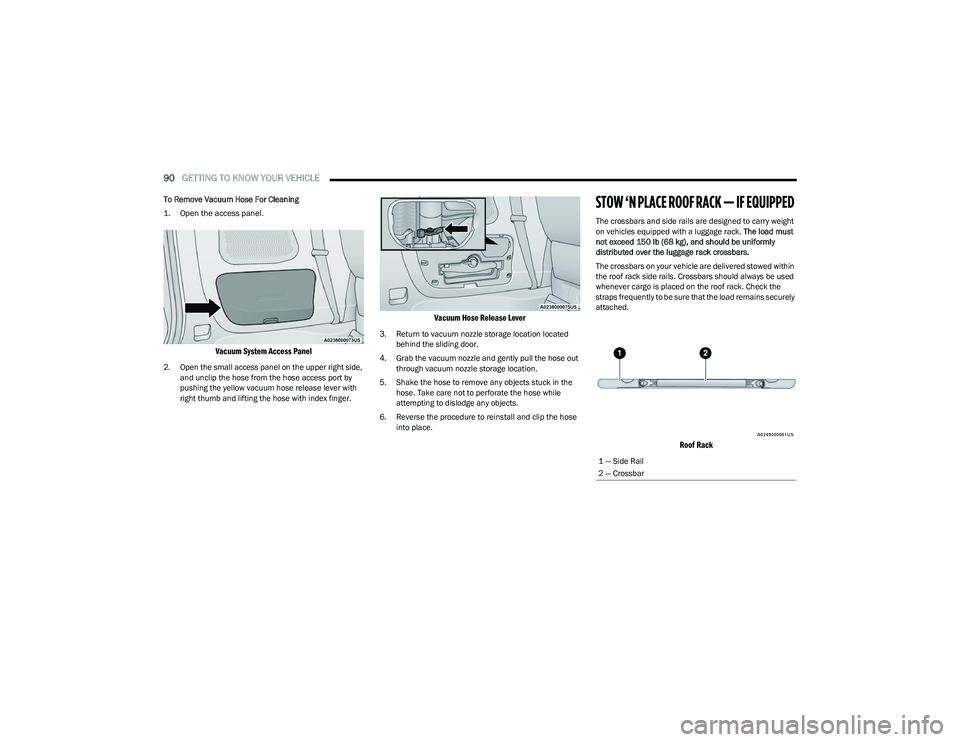
90GETTING TO KNOW YOUR VEHICLE
To Remove Vacuum Hose For Cleaning
1. Open the access panel.
Vacuum System Access Panel
2. Open the small access panel on the upper right side,
and unclip the hose from the hose access port by
pushing the yellow vacuum hose release lever with
right thumb and lifting the hose with index finger.
Vacuum Hose Release Lever
3. Return to vacuum nozzle storage location located behind the sliding door.
4. Grab the vacuum nozzle and gently pull the hose out through vacuum nozzle storage location.
5. Shake the hose to remove any objects stuck in the hose. Take care not to perforate the hose while
attempting to dislodge any objects.
6. Reverse the procedure to reinstall and clip the hose into place.
STOW ‘N PLACE ROOF RACK — IF EQUIPPED
The crossbars and side rails are designed to carry weight
on vehicles equipped with a luggage rack. The load must
not exceed 150 lb (68 kg), and should be uniformly
distributed over the luggage rack crossbars.
The crossbars on your vehicle are delivered stowed within
the roof rack side rails. Crossbars should always be used
whenever cargo is placed on the roof rack. Check the
straps frequently to be sure that the load remains securely
attached.
Roof Rack
1 — Side Rail
2 — Crossbar
23_RUP_OM_EN_USC_t.book Page 90
Page 93 of 328
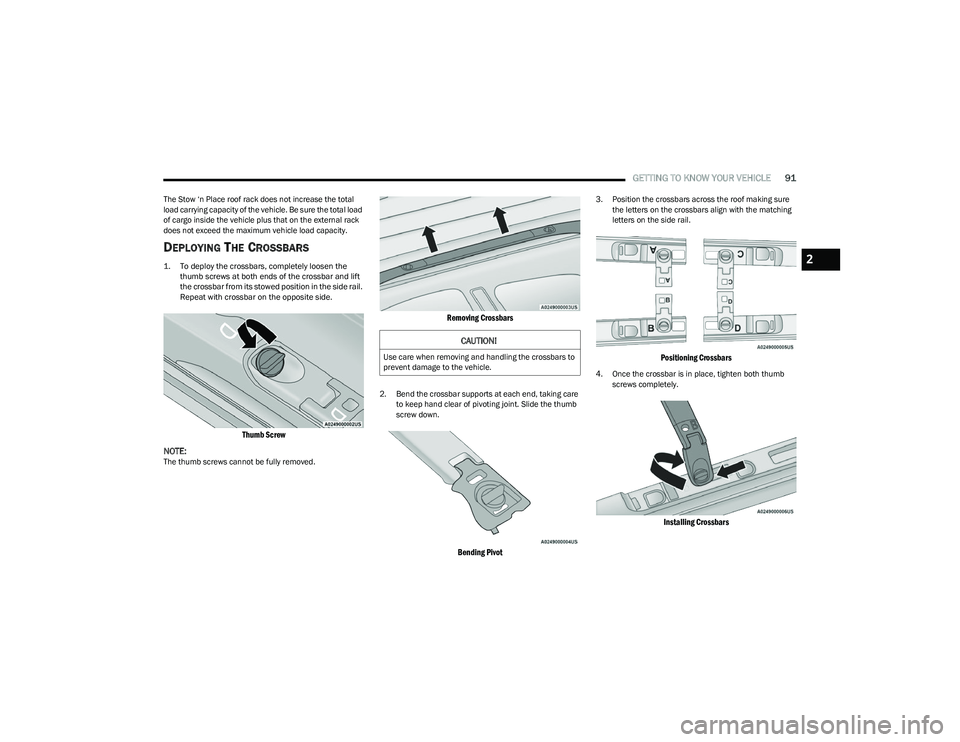
GETTING TO KNOW YOUR VEHICLE91
The Stow ‘n Place roof rack does not increase the total
load carrying capacity of the vehicle. Be sure the total load
of cargo inside the vehicle plus that on the external rack
does not exceed the maximum vehicle load capacity.
DEPLOYING THE CROSSBARS
1. To deploy the crossbars, completely loosen the
thumb screws at both ends of the crossbar and lift
the crossbar from its stowed position in the side rail.
Repeat with crossbar on the opposite side.
Thumb Screw
NOTE:
The thumb screws cannot be fully removed.
Removing Crossbars
2. Bend the crossbar supports at each end, taking care to keep hand clear of pivoting joint. Slide the thumb
screw down.
Bending Pivot
3. Position the crossbars across the roof making sure the letters on the crossbars align with the matching
letters on the side rail.
Positioning Crossbars
4. Once the crossbar is in place, tighten both thumb screws completely.
Installing Crossbars
CAUTION!
Use care when removing and handling the crossbars to
prevent damage to the vehicle.
2
23_RUP_OM_EN_USC_t.book Page 91
Page 95 of 328
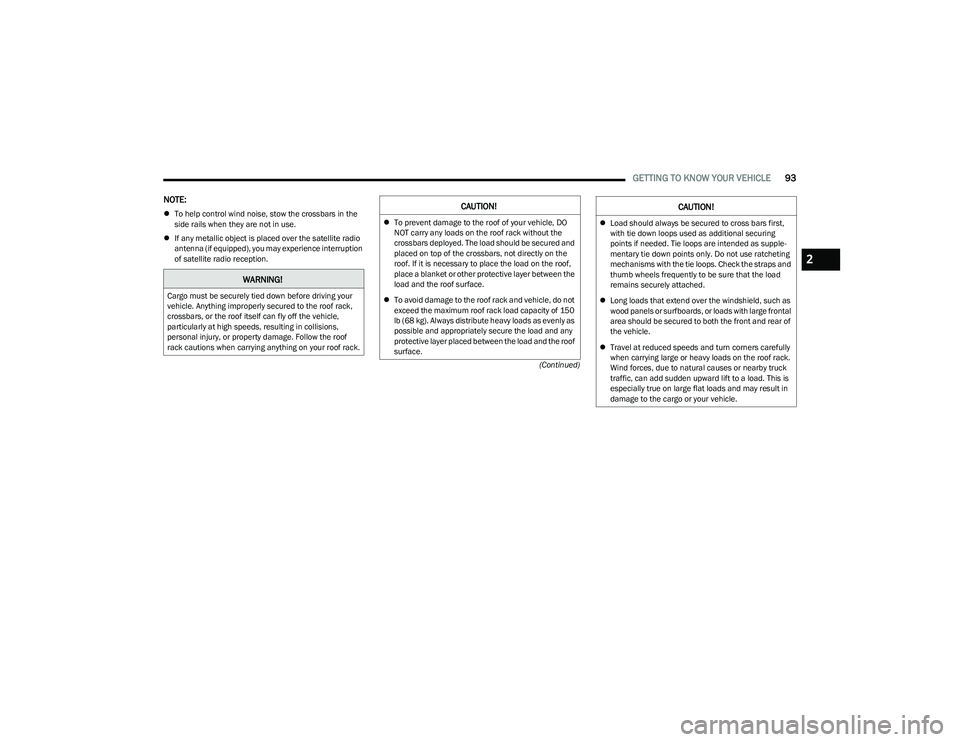
GETTING TO KNOW YOUR VEHICLE93
(Continued)
NOTE:
To help control wind noise, stow the crossbars in the
side rails when they are not in use.
If any metallic object is placed over the satellite radio
antenna (if equipped), you may experience interruption
of satellite radio reception.
WARNING!
Cargo must be securely tied down before driving your
vehicle. Anything improperly secured to the roof rack,
crossbars, or the roof itself can fly off the vehicle,
particularly at high speeds, resulting in collisions,
personal injury, or property damage. Follow the roof
rack cautions when carrying anything on your roof rack.
CAUTION!
To prevent damage to the roof of your vehicle, DO
NOT carry any loads on the roof rack without the
crossbars deployed. The load should be secured and
placed on top of the crossbars, not directly on the
roof. If it is necessary to place the load on the roof,
place a blanket or other protective layer between the
load and the roof surface.
To avoid damage to the roof rack and vehicle, do not
exceed the maximum roof rack load capacity of 150
lb (68 kg). Always distribute heavy loads as evenly as
possible and appropriately secure the load and any
protective layer placed between the load and the roof
surface.Load should always be secured to cross bars first,
with tie down loops used as additional securing
points if needed. Tie loops are intended as supple -
mentary tie down points only. Do not use ratcheting
mechanisms with the tie loops. Check the straps and
thumb wheels frequently to be sure that the load
remains securely attached.
Long loads that extend over the windshield, such as
wood panels or surfboards, or loads with large frontal
area should be secured to both the front and rear of
the vehicle.
Travel at reduced speeds and turn corners carefully
when carrying large or heavy loads on the roof rack.
Wind forces, due to natural causes or nearby truck
traffic, can add sudden upward lift to a load. This is
especially true on large flat loads and may result in
damage to the cargo or your vehicle.
CAUTION!
2
23_RUP_OM_EN_USC_t.book Page 93
Page 218 of 328
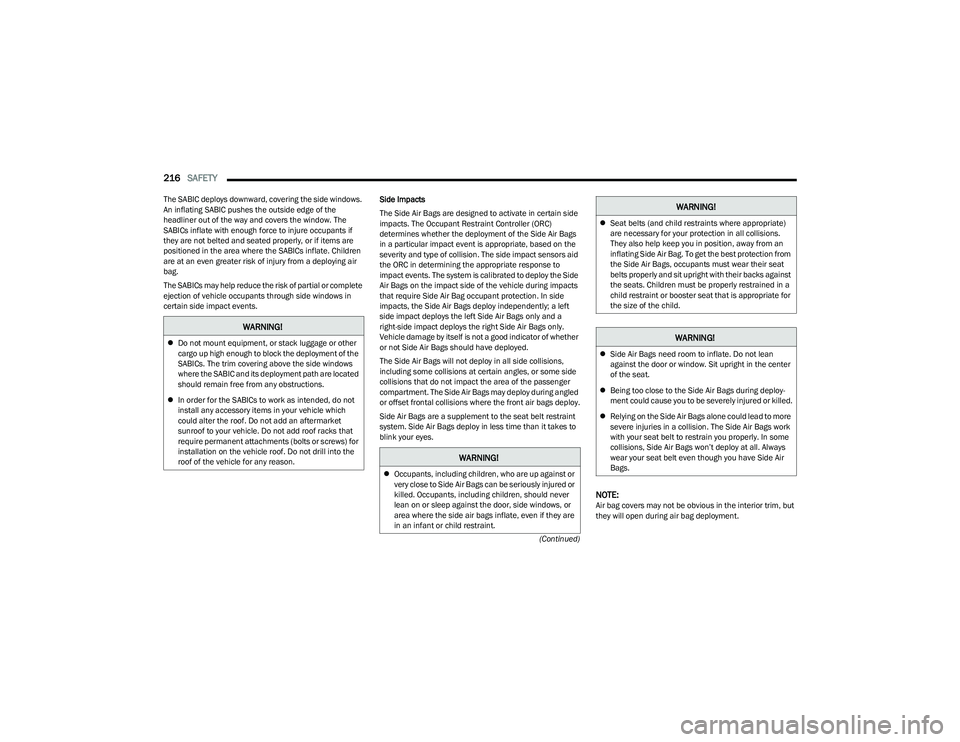
216SAFETY
(Continued)
The SABIC deploys downward, covering the side windows.
An inflating SABIC pushes the outside edge of the
headliner out of the way and covers the window. The
SABICs inflate with enough force to injure occupants if
they are not belted and seated properly, or if items are
positioned in the area where the SABICs inflate. Children
are at an even greater risk of injury from a deploying air
bag.
The SABICs may help reduce the risk of partial or complete
ejection of vehicle occupants through side windows in
certain side impact events.
Side Impacts
The Side Air Bags are designed to activate in certain side
impacts. The Occupant Restraint Controller (ORC)
determines whether the deployment of the Side Air Bags
in a particular impact event is appropriate, based on the
severity and type of collision. The side impact sensors aid
the ORC in determining the appropriate response to
impact events. The system is calibrated to deploy the Side
Air Bags on the impact side of the vehicle during impacts
that require Side Air Bag occupant protection. In side
impacts, the Side Air Bags deploy independently; a left
side impact deploys the left Side Air Bags only and a
right-side impact deploys the right Side Air Bags only.
Vehicle damage by itself is not a good indicator of whether
or not Side Air Bags should have deployed.
The Side Air Bags will not deploy in all side collisions,
including some collisions at certain angles, or some side
collisions that do not impact the area of the passenger
compartment. The Side Air Bags may deploy during angled
or offset frontal collisions where the front air bags deploy.
Side Air Bags are a supplement to the seat belt restraint
system. Side Air Bags deploy in less time than it takes to
blink your eyes.
NOTE:Air bag covers may not be obvious in the interior trim, but
they will open during air bag deployment.
WARNING!
Do not mount equipment, or stack luggage or other
cargo up high enough to block the deployment of the
SABICs. The trim covering above the side windows
where the SABIC and its deployment path are located
should remain free from any obstructions.
In order for the SABICs to work as intended, do not
install any accessory items in your vehicle which
could alter the roof. Do not add an aftermarket
sunroof to your vehicle. Do not add roof racks that
require permanent attachments (bolts or screws) for
installation on the vehicle roof. Do not drill into the
roof of the vehicle for any reason.
WARNING!
Occupants, including children, who are up against or
very close to Side Air Bags can be seriously injured or
killed. Occupants, including children, should never
lean on or sleep against the door, side windows, or
area where the side air bags inflate, even if they are
in an infant or child restraint.
Seat belts (and child restraints where appropriate)
are necessary for your protection in all collisions.
They also help keep you in position, away from an
inflating Side Air Bag. To get the best protection from
the Side Air Bags, occupants must wear their seat
belts properly and sit upright with their backs against
the seats. Children must be properly restrained in a
child restraint or booster seat that is appropriate for
the size of the child.
WARNING!
Side Air Bags need room to inflate. Do not lean
against the door or window. Sit upright in the center
of the seat.
Being too close to the Side Air Bags during deploy -
ment could cause you to be severely injured or killed.
Relying on the Side Air Bags alone could lead to more
severe injuries in a collision. The Side Air Bags work
with your seat belt to restrain you properly. In some
collisions, Side Air Bags won’t deploy at all. Always
wear your seat belt even though you have Side Air
Bags.
WARNING!
23_RUP_OM_EN_USC_t.book Page 216
Page 321 of 328
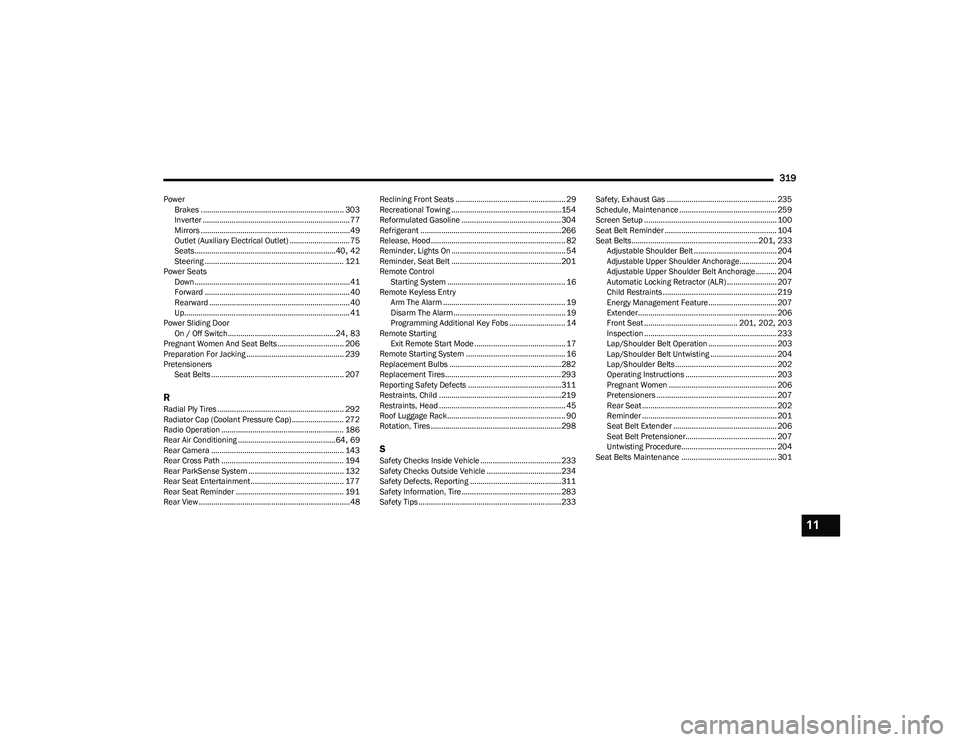
319
PowerBrakes ..................................................................... 303
Inverter ....................................................................... 77
Mirrors ........................................................................49
Outlet (Auxiliary Electrical Outlet) ............................. 75
Seats.................................................................... 40
, 42
Steering ................................................................... 121
Power Seats Down...........................................................................41
Forward ...................................................................... 40
Rearward ....................................................................40
Up................................................................................ 41
Power Sliding Door On / Off Switch.................................................... 24
, 83
Pregnant Women And Seat Belts................................ 206
Preparation For Jacking ............................................... 239
Pretensioners Seat Belts ................................................................ 207
RRadial Ply Tires ............................................................. 292
Radiator Cap (Coolant Pressure Cap) ......................... 272
Radio Operation ........................................................... 186
Rear Air Conditioning ............................................... 64
, 69
Rear Camera ................................................................ 143
Rear Cross Path ........................................................... 194
Rear ParkSense System .............................................. 132
Rear Seat Entertainment............................................. 177
Rear Seat Reminder .................................................... 191
Rear View .........................................................................48 Reclining Front Seats ..................................................... 29
Recreational Towing ..................................................... 154
Reformulated Gasoline ................................................ 304
Refrigerant ....................................................................266
Release, Hood................................................................. 82
Reminder, Lights On ....................................................... 54
Reminder, Seat Belt ..................................................... 201
Remote Control Starting System ......................................................... 16
Remote Keyless Entry Arm The Alarm ........................................................... 19
Disarm The Alarm ...................................................... 19
Programming Additional Key Fobs ........................... 14
Remote Starting Exit Remote Start Mode ............................................ 17
Remote Starting System ................................................ 16
Replacement Bulbs ...................................................... 282
Replacement Tires........................................................ 293
Reporting Safety Defects ............................................. 311
Restraints, Child ...........................................................219
Restraints, Head ............................................................. 45
Roof Luggage Rack......................................................... 90
Rotation, Tires ............................................................... 298SSafety Checks Inside Vehicle ....................................... 233
Safety Checks Outside Vehicle ....................................234
Safety Defects, Reporting ............................................311
Safety Information, Tire ................................................ 283
Safety Tips.....................................................................233 Safety, Exhaust Gas ..................................................... 235
Schedule, Maintenance ............................................... 259
Screen Setup ................................................................ 100
Seat Belt Reminder ...................................................... 104
Seat Belts............................................................. 201
, 233
Adjustable Shoulder Belt ........................................ 204 Adjustable Upper Shoulder Anchorage.................. 204
Adjustable Upper Shoulder Belt Anchorage .......... 204
Automatic Locking Retractor (ALR) ........................ 207
Child Restraints ....................................................... 219Energy Management Feature................................. 207Extender................................................................... 206
Front Seat ............................................. 201
, 202, 203
Inspection ................................................................ 233
Lap/Shoulder Belt Operation ................................. 203 Lap/Shoulder Belt Untwisting ................................ 204
Lap/Shoulder Belts ................................................. 202Operating Instructions ............................................ 203
Pregnant Women .................................................... 206
Pretensioners .......................................................... 207
Rear Seat ................................................................. 202
Reminder ................................................................. 201
Seat Belt Extender .................................................. 206
Seat Belt Pretensioner............................................ 207
Untwisting Procedure.............................................. 204
Seat Belts Maintenance .............................................. 301
11
23_RUP_OM_EN_USC_t.book Page 319